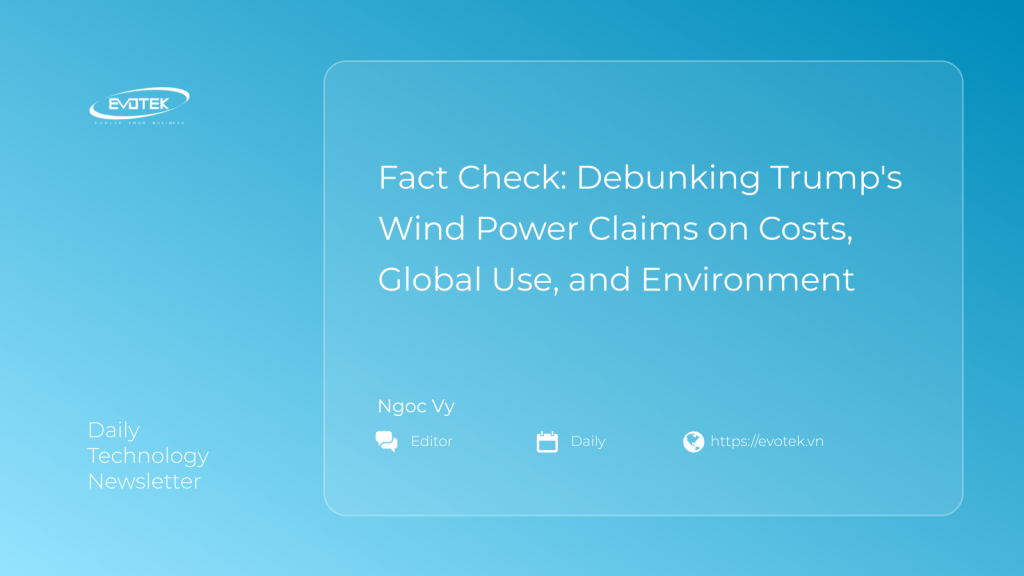During a recent Cabinet meeting, President Donald Trump voiced strong opposition to wind power, labeling it an overly expensive energy source avoided by “smart” nations. These remarks, coming shortly after an executive order aimed at reducing “green” energy subsidies, contained several assertions that warrant a closer look at the facts.
Claim: “Wind is a very expensive form of energy.”
The Facts: Contrary to the assertion, onshore wind power stands out as one of the most economical sources for electricity generation. Projections from the Energy Information Administration (EIA) estimate new onshore wind farms can produce electricity for approximately $30 per megawatt-hour. This is significantly more affordable compared to a new natural gas plant, which costs around $65 per megawatt-hour, or an advanced nuclear reactor, exceeding $80 per megawatt-hour.
Onshore wind farms generally incur lower construction and operational costs than natural gas plants across most parts of the United States, even without considering tax credits. While natural gas offers dispatchable power at any time, wind’s intermittency is managed within a diversified energy grid. It’s worth noting that offshore wind, though a crucial emerging technology, is indeed more expensive to build and operate, estimated at $88 per megawatt-hour by the EIA.
States that have substantially integrated onshore wind power into their grids, such as Iowa, Kansas, Oklahoma, and New Mexico, have experienced slower increases in electricity rates compared to other states over the past decade. For instance, Iowa saw its wind energy contribution surge from 15% in 2010 to nearly 60% by 2023, while its electricity rates rose at a slower pace than 42 other states, according to research from Energy Innovation.
Experts emphasize that wind power, especially when sited in areas with robust wind resources, plays a vital role in an overall electricity portfolio to keep energy costs down.
Claim: Wind turbines are “almost exclusively” made in China, and President Xi Jinping told Trump they have “very, very few.”
The Facts: China is indeed the world’s leading manufacturer of wind turbines, producing over half of the global supply. Furthermore, China is installing these turbines at an unprecedented rate within its own borders. A recent report by Global Energy Monitor highlighted China’s massive utility-scale wind and solar capacity in development—totaling 1.3 terawatts—which could generate more electricity than Japan consumed in all of 2023. China is also an undisputed global leader in the offshore wind sector.
While China continues to expand its coal and gas infrastructure, it is simultaneously building an extensive portfolio of zero-carbon resources. This strategy aims to reduce reliance on fossil fuels, countering a common Western narrative that China is not addressing its carbon footprint.
Claim: “If you look at smart countries, they don’t use it.”
The Facts: Data from the EIA shows that at least 136 countries and territories worldwide utilize wind power for electricity generation, with many significantly expanding their capacities. The Global Wind Energy Council identified China, the U.S., Brazil, India, and Germany as the top five markets for wind power in 2024. Emerging markets like Uzbekistan, Egypt, and Saudi Arabia represent the next wave of growth.
The year 2024 marked another record for wind energy growth globally, with the industry expanding into new regions. Experts strongly refute the notion that “smart countries” avoid wind power, pointing to nations like Germany, the United Kingdom, Finland, Spain, Sweden, and France, all of which have extensive wind energy development programs. Curtailing wind power development in the U.S. risks ceding leadership in this critical technology to countries like China and could lead to significant job losses.
Claim: In New England, two whales washed up over 50 years, “and last summer they had 14 washed up. Now, I’m not saying that’s the wind farm that was built, that maybe it is right.”
The Facts: The National Oceanic and Atmospheric Administration (NOAA) has found no known links between the recent large whale deaths and ongoing offshore wind activities. NOAA rigorously analyzes the causes of whale deaths based on scientific data. Claims connecting these incidents to offshore wind development are unfounded and often emerge as a flashpoint in debates over renewable energy expansion.
The U.S. has a limited number of operational offshore wind projects. The nation’s first commercial-scale offshore wind farm opened in 2024 off Montauk Point, New York. A five-turbine pilot project has been running since 2016 off the coast of Rhode Island, and the second-largest offshore wind farm is currently under construction off Massachusetts.
Claim: “The birds are dying all over the place.”
The Facts: Like all infrastructure, wind turbines can pose a risk to birds. However, the National Audubon Society, a leading bird conservation organization, asserts that these risks are manageable, and climate change presents a far greater threat to avian populations. An Audubon report revealed that two-thirds of North American bird species could face extinction due to rising temperatures.
The nonprofit explicitly stated in January that responsible offshore wind development offers significant benefits for birds, the U.S. economy, and the climate. Scientific findings indicate that offshore wind can be deployed in a manner that protects birds and their habitats. The organization also supports onshore wind energy when it is properly sited and operated to minimize impacts on wildlife.
Claim: “You can’t take them down because the environmentalists don’t let you bury the blades.”
The Facts: The recycling of wind turbine blades presents a genuine challenge due to their durable design, built to withstand extreme weather. However, the U.S. possesses the infrastructure to recycle the majority of wind turbine materials. A January report from the Department of Energy found that 90% of wind turbines can be recycled using existing methods, with new strategies and innovative recycling techniques being developed to address the remaining materials.
The wind power industry acknowledges the issue of blade disposal. Danish wind energy developer Ørsted, for example, made a commitment in 2021 to never send turbine blades to landfills, opting instead for their reuse, recycling, or recovery.

 日本語
日本語 한국어
한국어 Tiếng Việt
Tiếng Việt 简体中文
简体中文